Integrated Pest Management of Flies in Texas Dairies
Introduction
Click for full PDF publication
- Intro
- Fly Management Problems
- Major Pest Flies
- Integrated Pest Management
Authors:
Douglass E. Stevenson | Extension Associate
Jesse Cooke | Extension Entomologist
Texas A&M University System
Intro
Flies in diaries are managed best when producers coordinate several methods that together offer good control at low cost. Called integrated pest management (IPM), this approach reduces dependence on chemicals, instead combining sanitation practices, biological control and chemical agents to reduce fly populations.
Fly Management Problems
The integrated approach to fly control is needed because:
- Fewer effective fly-control insecticides are available.
- Flies are becoming more resistant to insecticides.
- New regulations require reductions of insecticide residues in food.
- People need to reduce their exposure to insecticides.
- Dairy systems are expanding, producing more intense fly breeding.
- Concern is growing over the cost/benefits of fly control in dairies.
- Flies harm animals and lower milk production.
- The public is more aware of the health and annoyance problems flies cause.
Dairy producers need to understand the factors producing fly populations, including climate, regional terrain, management practices and production facility design. To keep fly populations the lowest at the least cost, producers should take action at decisive times in the pests’ life cycle. Knowing the biology of the major fly pests — houseflies, stable flies, horn flies, garbage flies and blowflies — can help producers implement a successful dairy IPM program.

Major Pest Flies
Housefly (Musca domestica L.)
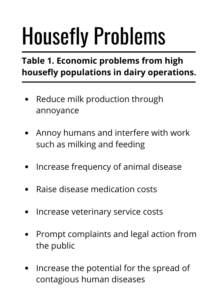 The most common, most prolific and most costly fly pest in dairies is the housefly (Figure 1). Besides annoying animals and people, houseflies spread diseases from animal to animal and to humans.
The most common, most prolific and most costly fly pest in dairies is the housefly (Figure 1). Besides annoying animals and people, houseflies spread diseases from animal to animal and to humans.
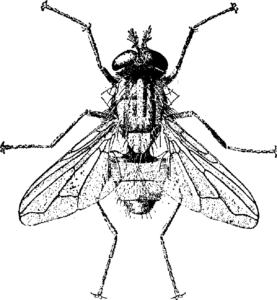
Fig. 1 Housefly adult
Life cycle
The housefly passes through four life stages: egg, larva (maggot), pupa and winged adult. Under ideal conditions, the life cycle may be as short as six days. In Texas, two to three generations may develop per month during warm months. Adult female flies have been known to lay more than 2,000 eggs, but normally produce about 500 to 600 eggs during their lifetime. Eggs are laid in clusters of 75 to 150 every three to four days during a 31-day period.
Flies usually deposit eggs in wet, decaying organic matter such as manure and spilled feed. After hatching, the cream-colored fly larva, or maggot (Figure 2), feeds from four to six days. The fly grows during the larval stage, the size of the adult being dependent on how big the larva grows during feeding.
After feeding, the maggots crawl away from moist feeding areas to a dry habitat to pupate. They may spend three to four days in this prepupal or migratory stage before pupating in dry feed or manure. Once at rest, the larva transforms into a brown, nonfeeding seed-like pupa. The pupa remains stationary until it emerges from the old larval and pupal skins as an adult fly.
Under ideal conditions, houseflies multiply quickly. Just one pound of wet manure can yield more than 1,500 maggots. It is possible for 1,000 pounds of wet manure to harbor 1.5 million larvae. This means that even small breeding areas can produce many flies.

Fig. 2 Housefly maggot
Economic importance
Houseflies can spread diseases and parasites from one animal to another and to humans. Their feeding method and ability to carry diseases make them a constant threat to milk production and animal and human health (Table 1).
The housefly can consume food only in liquid form. When feeding, it frequently regurgitation droplets of food and saliva from its sponging mouthparts (Figure 3). Regurgitation helps the fly liquefy solid food. Then it can reconsume the mixture as it feeds on various food sources.
Male and female adult flies eat feed, excrement and other decaying organic matter. They usually pick up pathogens and parasites by walking over materials containing them, contaminating their wings and feet. When feeding, the flies’ intestinal
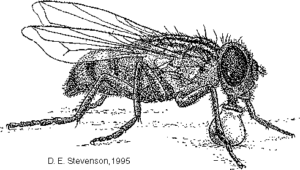
Fig. 3 Housefly regurgitating while feeding
contents also become loaded with disease agents. The flies redeposit the disease agents each time they defecate, feed or vomit.
In a dairy, heavy housefly populations can cause serious economic problems (Table 2). Virus diseases carried by flies include bovine virus diarrhea (BVD), the bovine herpesvirus (BHV-1) causing infectious bovine rhinitis (IBR), and parainfluenza 3 (PI3). Fly-borne bacterial diseases include pink eye, mastitis, bacterial scours, typhoid, anthrax, vibriosis and several clostridial diseases.
Houseflies have harbored more than 100 different species of pathogenic organisms. Studies have incriminated them in more than 65 human and animal diseases. They also can transport eggs and infectious larvae of several important parasitic worms.
Economic thresholds have not been established for housefly populations in dairies. However, nuisance levels (Table 3) that annoy animals correlate closely with the incidence of such diseases as pink eye and mastitis. Tolerance levels often depend on the size of the area infested with flies.
Left unmanaged, houseflies can irritate cows, lowering feed conversion and milk production. Similarly, pink eye, mastitis and other infectious diseases may spread more rapidly through the herd. Cow irritability and disease raise labor, medication and veterinary costs. Income also drops with production losses.
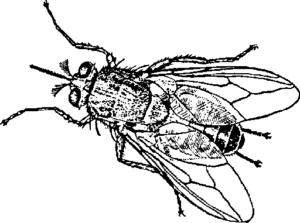
Fig. 4 Stable fly adult
Stable fly (Stomoxys calcitrans (L.))
 The stable fly (Figures 4 and 5) feeds on blood. Although it is in the same family as the housefly and resembles it slightly, the stable fly bites aggressively. It is easily distinguished from the housefly by its piercing-sucking mouthparts, which it carries in a sheath projecting forward from under the head. When feeding, the stable fly inserts its mouthparts into the host to withdraw blood. Both males and females feed on blood, frequently changing position on the animal or moving to other hosts until they have engorged themselves with blood.
The stable fly (Figures 4 and 5) feeds on blood. Although it is in the same family as the housefly and resembles it slightly, the stable fly bites aggressively. It is easily distinguished from the housefly by its piercing-sucking mouthparts, which it carries in a sheath projecting forward from under the head. When feeding, the stable fly inserts its mouthparts into the host to withdraw blood. Both males and females feed on blood, frequently changing position on the animal or moving to other hosts until they have engorged themselves with blood.
Stable flies also differ from houseflies in that they require a looser, drier environment and a superior diet. Stable flies prefer an un-digested food supply higher in protein. They breed in decaying hay, straw, grain and mixtures of grain, manure and hay residue. Ideal breeding sites are manure piles containing mixtures of manure, urine-soaked bedding, straw and undigested feed. Stable flies develop less well in manure than in manure mixed with undigested food.
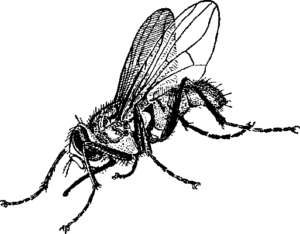
Stable fly adult, side view
Life cycle
The female stable fly crawls into loose breeding material and deposits from 25 to 50 eggs at each egg-laying site. It may lay as many as 600 eggs during its lifetime. In about three days, the eggs hatch into larvae, which feed for about two weeks before transforming into the nonfeeding pupal stage. In about 10 days, the adult stable fly emerges. On average, the life cycle from egg to adult requires about 28 days.
After mating, female adults return to their breeding sites to lay eggs. Soggy, fermenting hay and manure residue left in piles or underfeed bunks is an ideal habitat for larval development. Old straw piles that remain moist during spring, summer and fall can harbor large fly populations.
Economic importance
Stable flies irritate cattle during resting, feeding and milking. Research shows that high populations of stable flies can lower milk production by 15 to 30 percent.
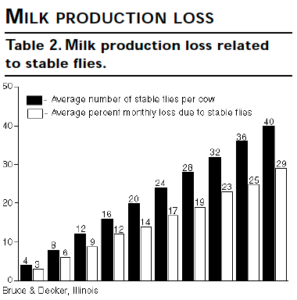
Stable flies usually bite during daylight hours. They can irritate cows so severely during milking that some cows kick off their milkers. They also bite humans and can torment
workers during milking and feeding. Stable flies may travel several miles to find blood meals and suitable breeding sites.
The stable fly also can carry several ani-mal diseases, including anthrax and trypanosomiasis.
Horn fly (Haematobia irritans (L.))
About half the size of the housefly or stable fly, the horn fly (Figure 6) is similar in color to the stable fly and also feeds on blood. Horn flies remain on the cow all the time. Females leave the animal only to deposit eggs on fresh manure.
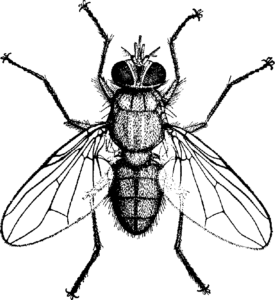
Fig. 6 Horn fly
Life cycle
A horn fly lays eggs in groups of three to seven on the manure surface, rarely depositing more than 20 eggs. Larvae hatch within 24 hours. They develop rapidly, reaching complete growth in three to five days. Then they crawl to drier parts of the manure to pupate and remain in the pupal stage for six to eight days before emerging as adults.
Under ideal conditions, the entire life cycle from egg to adult takes from 10 to 14 days. After emerging, adults fly to animals where they remain.
Economic importance
Constant feeding by heavy horn fly populations annoys, irritates and takes blood from cattle, causing them to lose weight and eat much more feed than necessary. Cows heavily attacked by horn flies may lose half a pound of body weight per day. Milk production may drop as much as 10 to 20 percent.
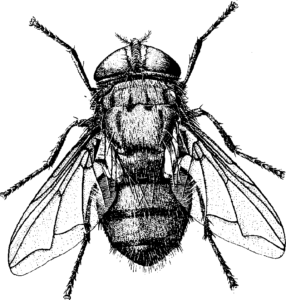
Fig. 7 Black garbage fly
Garbage and blowflies
Black garbage flies (Ophyra spp.)
Sometimes called “dump flies,” garbage flies (Figure 7) are shiny black and about two-thirds the size of houseflies, with a similar life cycle. Garbage flies breed in the same habitat as houseflies and may become very abundant. Two species, Ophyra ignava (Harris) and Ophyra aenescens (Wiedemann), inhabit con-fined animal facilities in the United States.
Garbage fly larvae feed on housefly larvae and may reduce housefly numbers while increasing their own. They may become almost as annoying as houseflies when the two occur together.
Blowflies (Family calliphoridae)
Several species of blowflies, including the black blowfly (Figure 8), Phormia regina (Meigen), inhabit confined animal production facilities. They are robust flies with a metallic sheen to the body. Species vary in color, ranging from green and blue to bronze-black and the color of a new penny. Ordinarily larger than houseflies, green blowflies and blue blowflies have stout bristles but no stripes on the back or thorax (Figures 9 and 10).
The blowfly life cycle is similar to the housefly. It passes from white eggs through three larval (maggot) stages (Figure 11), a pupal and an adult stage. To develop, however, blowflies require a wet medium
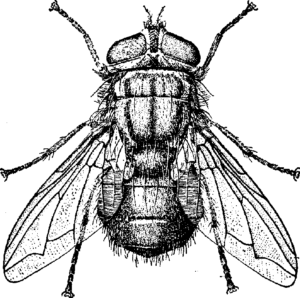
Fig. 8 Black blowfly
and a diet rich in animal protein. They prefer to breed in decomposing animal carcasses, afterbirth and areas contaminated with spilled milk. Though less well, they can develop in decaying manure and spilled feed when other food sources are unavailable.
Good sanitation can prevent major problems with garbage and blowflies.
Integrated Pest Management – IPM
Dairy flies can be managed effectively and economically using integrated pest management. IPM is not a way to control pests, but a way of thinking about pest control. It links many control methods into one system, excluding any that disrupt or diminish the effectiveness of the others. In IPM, all control methods must support each other.
Figure 12 shows a decision-making flow chart that includes four courses of action: chemical; larvacide-supplemented; IPM; and spray-as-needed, late-season suppression. All but the IPM program depend almost exclusively on chemical control methods. Larvicide-supplemented control is simply a variation of chemical control.
The spray-as-needed plan to defer any action until flies reach problem levels carries the highest risk. Putting off a decision until later in the season or adopting a “wait-and-see” attitude allows fly populations to explode. Sometime in mid or late summer, fly populations will multiply out of control. No amount of late-season spraying will bring an exploding population under control. The flies will have the day.
The IPM strategy uses as many nontoxic or nonlethal methods as possible to suppress fly population growth. It unites sanitation, biological control and chemical agents to manage flies effectively and economically. Compared to other approaches, the IPM method usually presents the lowest expenses and risks.
Dairy fly IPM activities should begin in winter or spring before flies are active and continue until fly activity shuts down at the end of the season. A good fly-control plan includes sanitation, biological control and chemical agents.

For more information and pesticide recommendations, download the full PDF.
